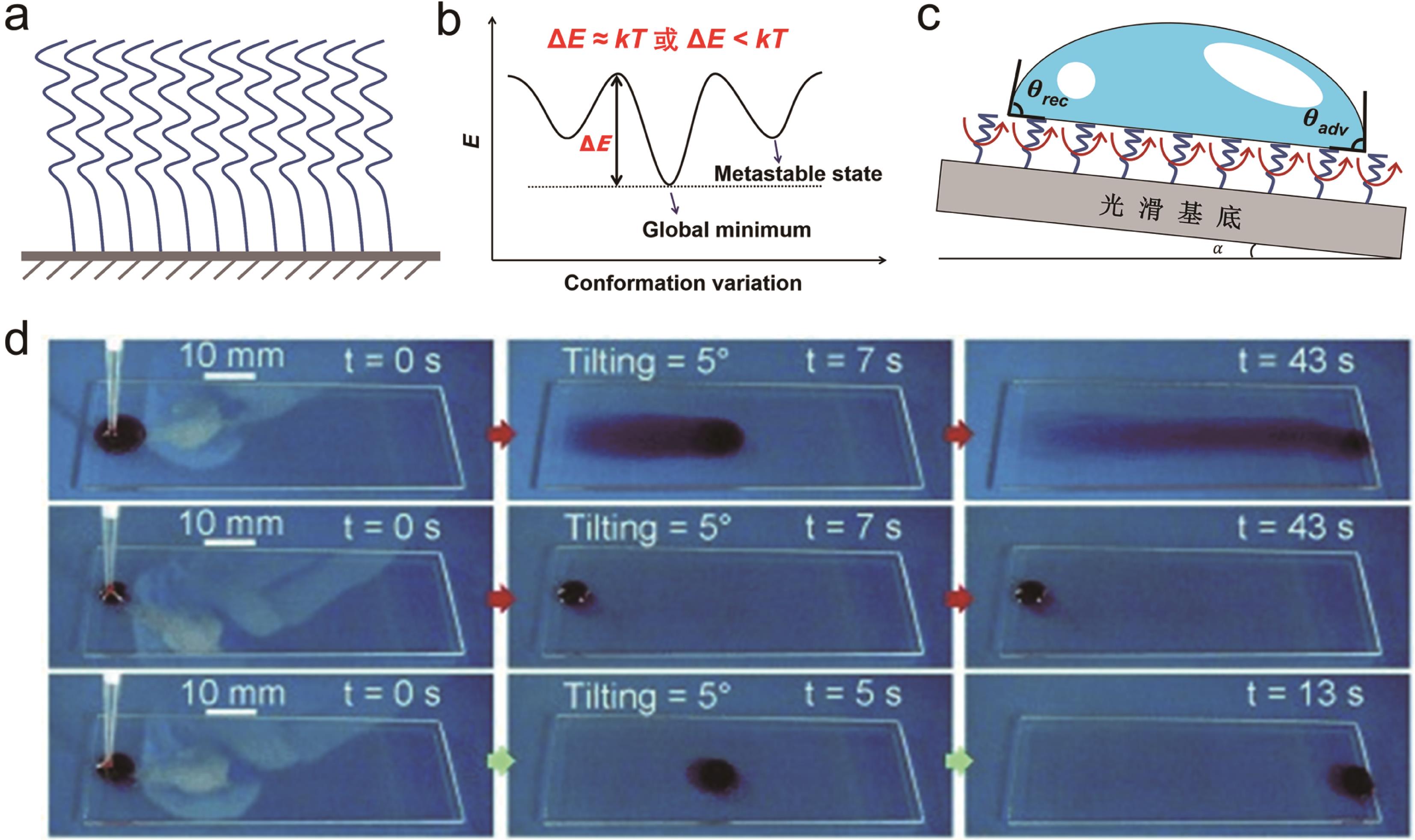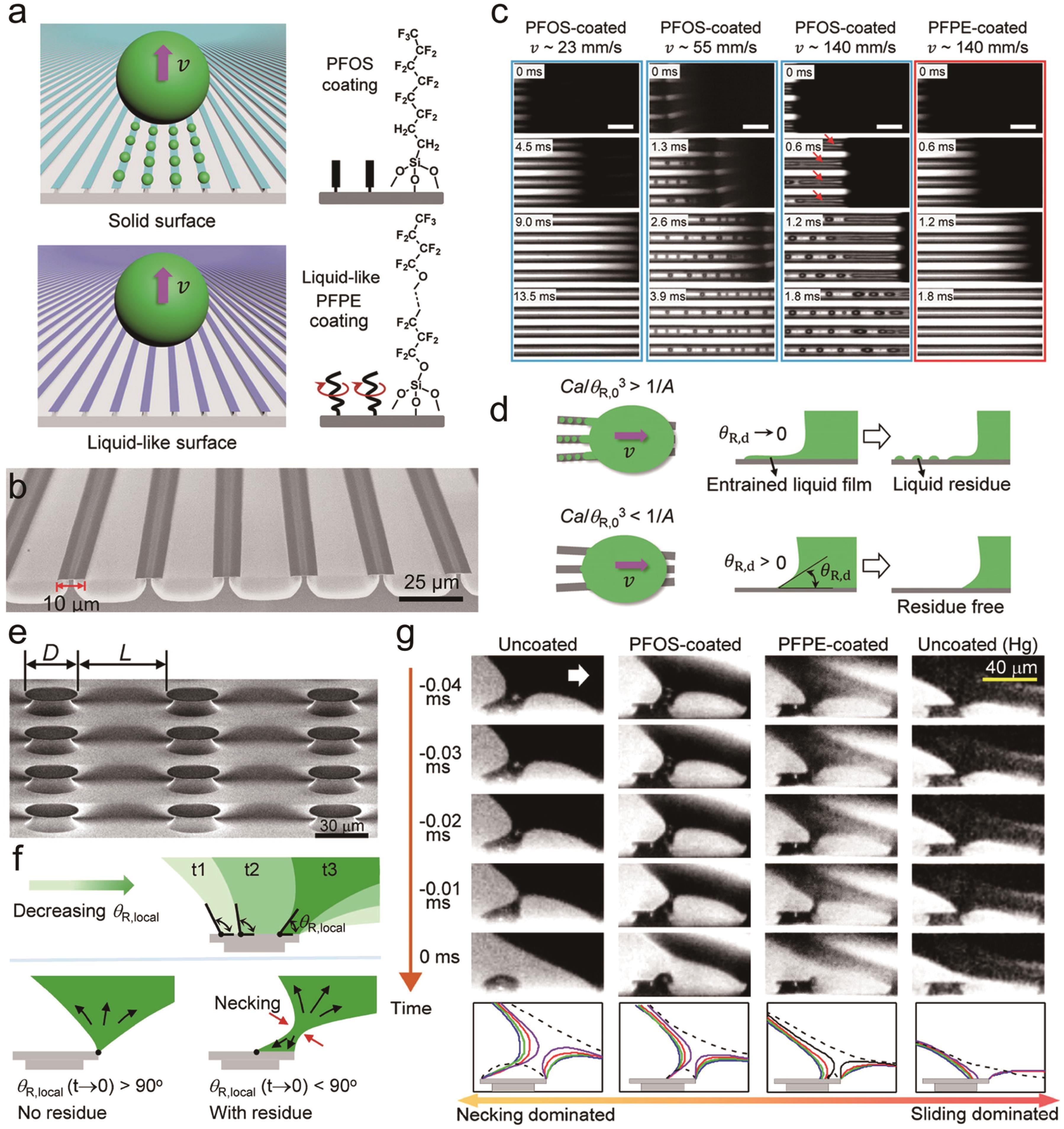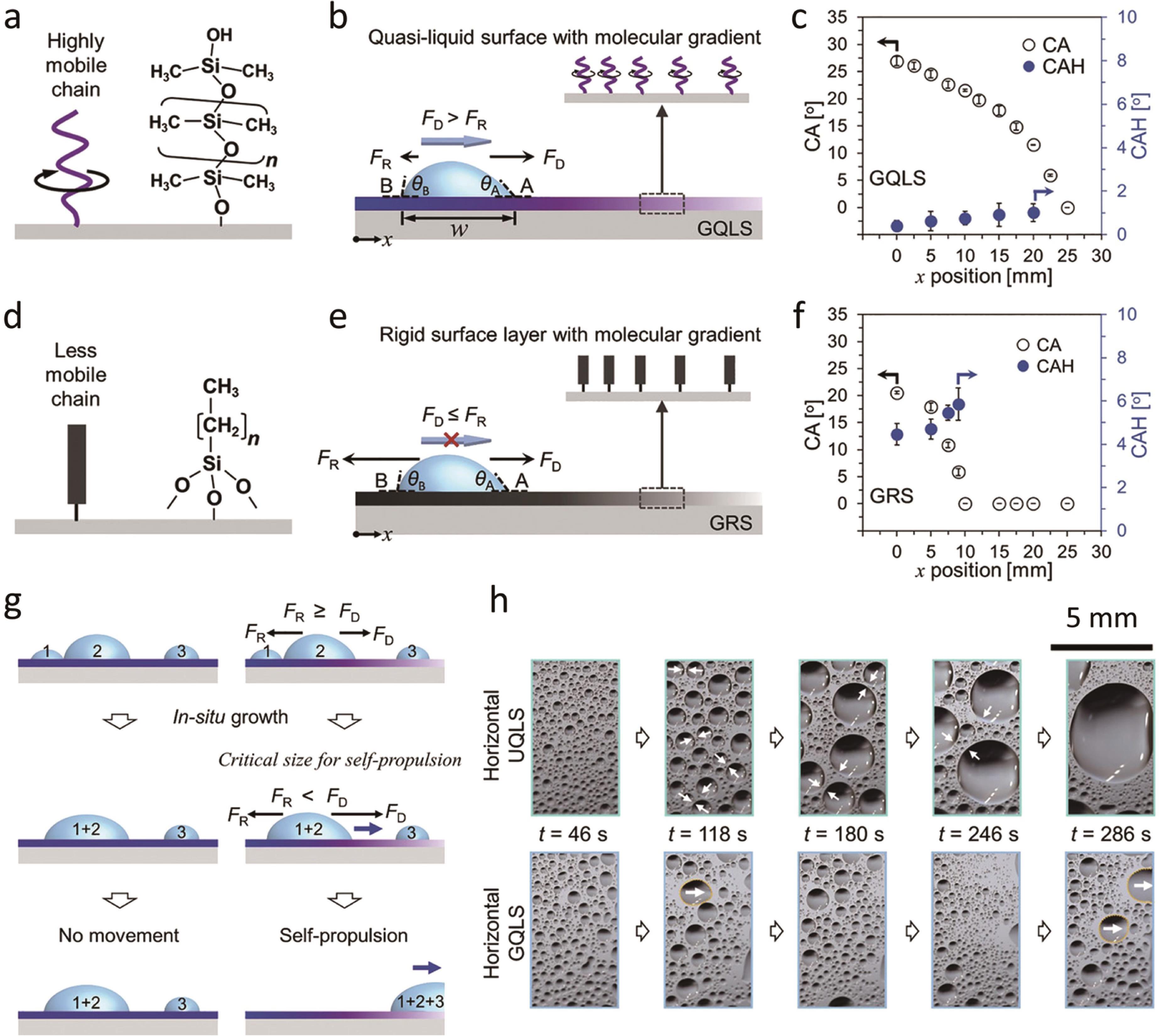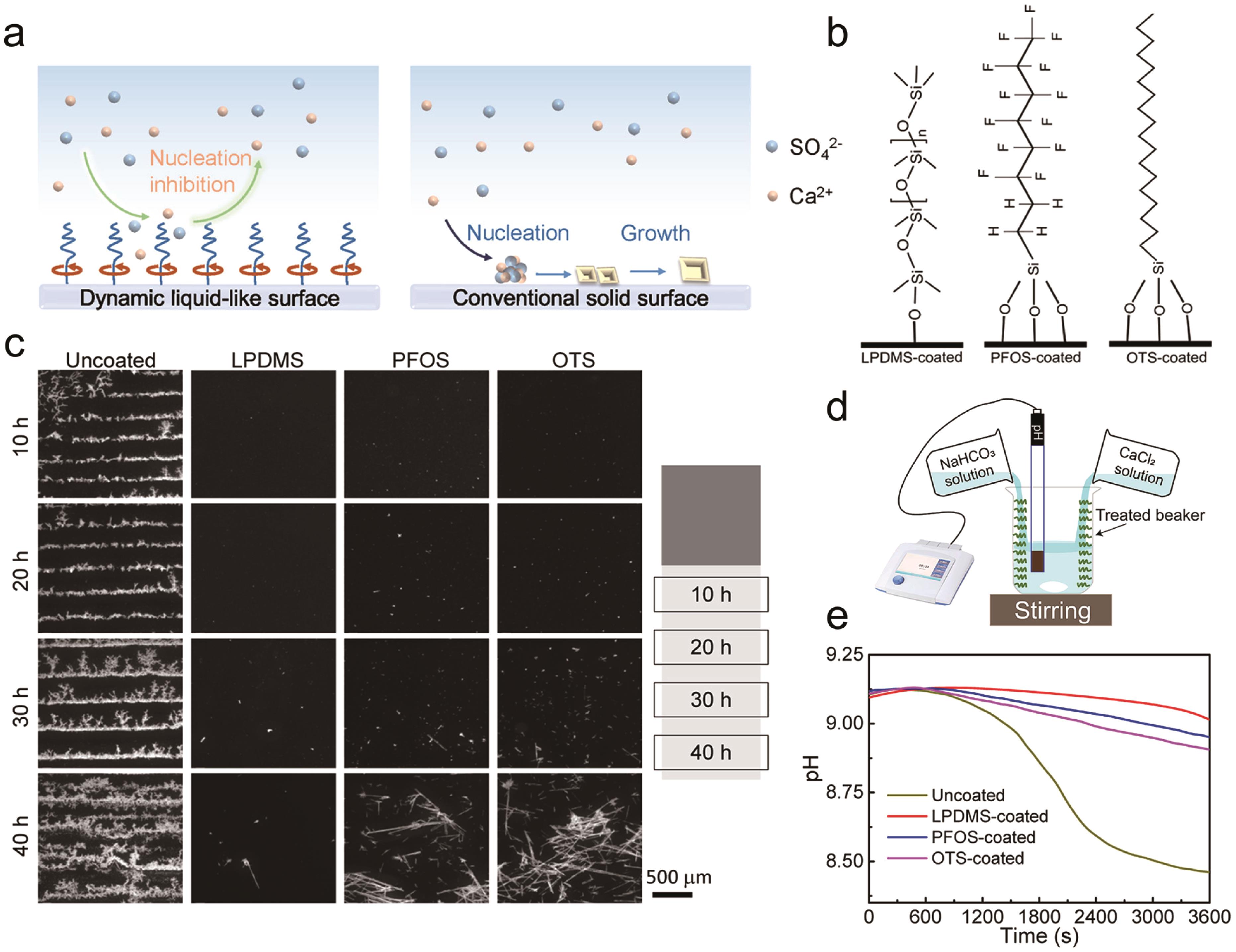
Chinese Journal of Applied Chemistry ›› 2022, Vol. 39 ›› Issue (1): 131-141.DOI: 10.19894/j.issn.1000-0518.210490
• Review • Previous Articles Next Articles
Liquid⁃like Dynamic Interfacial Materials: Recent Progress on Their Applications
- School of Materials Science and Engineering,Sun Yat-sen University,Guangzhou 510006,China
-
Received:2021-10-03Accepted:2021-11-05Published:2022-01-01Online:2022-01-10 -
Contact:Xue-Lin TIAN -
About author:tianxuelin@mail.sysu.edu.cn
-
Supported by:the National Natural Science Foundation of China(21872176);the Pearl River Talents Program(2017GC010671)
CLC Number:
Cite this article
FAN Yue, TIAN Xue-Lin . Liquid⁃like Dynamic Interfacial Materials: Recent Progress on Their Applications[J]. Chinese Journal of Applied Chemistry, 2022, 39(1): 131-141.
share this article
Add to citation manager EndNote|Ris|BibTeX
URL: http://yyhx.ciac.jl.cn/EN/10.19894/j.issn.1000-0518.210490

Fig.1 The concept of liquid-like surfaces[19]a.Schematic of flexible polymer brush grafted on a solid surface. b.Energy barrier for conformational transition of chemical bonds. c.Side-view schematic of a droplet sliding on a liquid-like surface with a receding angle (θrec) slightly larger than its advancing angle (θadv). d.Time-sequence images show toluene droplets (20 μL, dyed with Oil red) sliding on a pristine glass slide, a glass slide with perfluoroalkylsilane coating and a glass with liquid-like linear PDMS coating (from top to bottom)

Fig.2 Liquid-like dynamic interface materials for elimination of microscopic liquid residue[26-27]a.Lossless drop transport on the array of microstripes with liquid-like PFPE coating. b.SEM images showing the surface morphology of arrayed microstripes. c.In situ observation of formation process of liquid residue on parallel microstripes coated with PFOS (three left panels) and PFPE (the rightmost panel). The scale bars are 40 μm. Nonvolatile IL1 is used as the probe liquid. d.Formation mechanisms of microscopic liquid residue. e.SEM images showing the surface morphology of arrayed micropillars. f.Schematic showing the evolution process of microcapillary bridges. g.Fast evolution dynamics of the microcapillary bridges just before pinch-off. Profiles of the liquid-air interfaces at -0.04 ms (solid blue lines), -0.03 ms (green lines), -0.02 ms (red lines), -0.01 ms (purple lines), and 0 ms (dash black lines) are given below the microscopic images. The columns in this image from left to right represent ionic liquid on uncoated micropillars, ionic liquid on PFOS-coated micropillars, ionic liquid on PFPE-coated micropillars and mercury on uncoated micropillars, respectively

Fig.3 Self-propulsion of liquids on the chemically gradient quasi-liquid surface (GQLS) and its effect on enhancement of condensation heat transfer[28]a.Tethered polydimethylsiloxane molecule on the surface with high molecular mobility. b.Side-view schematic of droplet motion on GQLS. c.Variation of contact angle (CA) and contact angle hysteresis (CAH) of along the surface of GQLS. d.The rigid coating of alkylsilane with low molecular mobility. e.Side-view schematic of the gradient rigid surface (GRS) which is formed by vapor diffusion grafting of octyltrichlorosilane. f.Variation of CA and CAH along the GRS in the x-direction. g.Schematic showing in situ droplet growth, merging and transport behaviors on uniform quasi-liquid surface (UQLS) and GQLS, respectively. h.Time-sequence images compare droplet condensation behaviors on UQLS and GQLS. Droplets of smaller critical size can move away from GQLS by self-propulsion, which prevents the formation of big droplets. The scale bar is 5 mm and the probe liquid is FC40

Fig.4 Liquid-like linear polydimethylsiloxane (LPDMS) brush coating for anti-scaling applications[29]a.Schematic diagram showing superior anti-scaling capability of dynamic liquid-like surfaces. b.Schematic illustration of the LPDMS-, PFOS-, and OTS-coated surfaces. c.Optical images showing time-dependent scaling behaviors of different samples after 10, 20, 30 and 40 h of solution evaporation. d.Schematic diagram of the experimental setup for CaCO3 scaling tests. e.Time-dependent pH change against different coatings

Fig.5 Quasi-liquid LPDMS polymer coating with increased thickness for reducing ice adhesion and passive removal of ice[31]a.One-step self-catalyzed grafting of LPDMS on a hydroxylated substrate. b.Schematic of droplet sliding on a tilted Quasi-liquid surface (QLS), where the mobile chain maintains its high mobility through rotational and/or bending motions of the Si-O-Si skeleton. c.Water contact angle hysteresis (CAH) as a function of heating time at 105 °C on the QLS with a silicon substrate. The insets show the stable effect of the QLS since a 5 μL water droplet can still slide on the QLS after more than 3 months. d.Shear strength of ice on the quasi-liquid coating with 30.1 nm thickness (QLS), quasi-liquid coating with 5.0 nm thickness (SOCAL), cross-linked PDMS, and bare glass surface. The inset shows the schematic diagram for the tests. e.Comparison of the maximal shear force of ice on the abraded QLS and SOCAL, which are abraded after 10 cycles with a load of 10.2 kg. The inset shows the test setup. f.The detachment of ice on the abraded QLS and the abraded SOCAL under the influence of wind with 4.6 kPa pressure.

Fig.6 Liquid-like LPDMS functionalized membrane for separation of highly viscous oil/water system[33]a.Preparation of liquid-like stainless steel meshes membranes (LPDMS-SSM) by covalently grafting highly flexible liquid-like LPDMS polymer brushes and the schematic of its fast permeation towards highly viscous oils. b.Schematic and experimental set-up of crude oil-water separation test. c.Real-time monitoring the weight variation of separated crude oil as a function of time for different membranes. d.Average oil fluxes within 8 min and terminal oil fluxes at the 8th min in the separation. e - g.Plots of time-weight for oil permeation test, average permeate fluxes within 10 min, and terminal permeate fluxes at the 10th minute for viscosities of crude oils at 132.9 mPa·s, 30.9 mPa·s, and 25.6 mPa·s (from top to bottom)
| 1 | LIU M J, WANG S T, JIANG L. Nature-inspired superwettability systems[J]. Nat Rev Mater, 2017, 2(7): 1-17. |
| 2 | FENG L, LI S H, LI Y S, et al. Super-hydrophobic surfaces: from natural to artificial[J]. Adv Mater, 2002, 14(24): 1857-1860. |
| 3 | WONG T S, KANG S H, TANG S K Y, et al. Bioinspired self-repairing slippery surfaces with pressure-stable omniphobicity[J]. Nature, 2011, 477(7365): 443-447. |
| 4 | PARKER A R, LAWRENCE C R. Water capture by a desert beetle[J]. Nature, 2001, 414(6859): 33-34. |
| 5 | ZHENG Y M, BAI H, HUANG Z B, et al. Directional water collection on wetted spider silk[J]. Nature, 2010, 463(7281): 640-643. |
| 6 | JU J, BAI H, ZHENG Y M, et al. A multi-structural and multi-functional integrated fog collection system in cactus[J]. Nat Commun, 2012, 3(1): 1-6. |
| 7 | GAO X F, JIANG L. Water-repellent legs of water striders[J]. Nature, 2004, 432(7013): 36-36. |
| 8 | ZHENG Y M, GAO X F, JIANG L. Directional adhesion of superhydrophobic butterfly wings[J]. Soft Matter, 2007, 3(2): 178-182. |
| 9 | TIAN Y, SU B, JIANG L. Interfacial material system exhibiting superwettability[J]. Adv Mater, 2014, 26(40): 6872-6897. |
| 10 | WEN L P, TIAN Y, JIANG L. Bioinspired super-wettability from fundamental research to practical applications[J]. Angew Chem Int Ed, 2015, 54(11): 3387-3399. |
| 11 | SU B, TIAN Y, JIANG L. Bioinspired interfaces with superwettability: from materials to chemistry[J]. J Am Chem Soc, 2016, 138(6): 1727-1748. |
| 12 | LAI Y K, TANG Y X, GONG J P, et al. Transparent superhydrophobic/superhydrophilic TiO2-based coatings for self-cleaning and anti-fogging[J]. J Mater Chem, 2012, 22(15): 7420-7426. |
| 13 | CAO L L, JONES A K, SIKKA V K, et al. Anti-icing superhydrophobic coatings[J]. Langmuir, 2009, 25(21): 12444-12448. |
| 14 | ZHANG P, LV F Y. A review of the recent advances in superhydrophobic surfaces and the emerging energy-related applications[J]. Energy, 2015, 82: 1068-1087. |
| 15 | KIM P, WONG T S, ALVARENGA J, et al. Liquid-infused nanostructured surfaces with extreme anti-ice and anti-frost performance[J]. ACS Nano, 2012, 6(8): 6569-6577. |
| 16 | BOCQUET L, LAUGA E. A smooth future?[J] Nat Mater, 2011, 10(5): 334-337. |
| 17 | POETES R, HOLTZMANN K, FRANZE K, et al. Metastable underwater superhydrophobicity[J]. Phys Rev Lett, 2010, 105(16): 166104. |
| 18 | CAO M Y, GUO D W, YU C M, et al. Water-repellent properties of superhydrophobic and lubricant-infused “slippery” surfaces: a brief study on the functions and applications[J]. ACS Appl Mater Interfaces, 2016, 8(6): 3615-3623. |
| 19 | WANG L M, MCCARTHY T J. Covalently attached liquids: instant omniphobic surfaces with unprecedented repellency[J]. Angew Chem Int Ed, 2016, 55(1): 244-248. |
| 20 | SINGH N, KAKIUCHIDA H, SATO T, et al. Omniphobic metal surfaces with low contact angle hysteresis and tilt angles[J]. Langmuir, 2018, 34(38): 11405-11413. |
| 21 | CHENG D F, URATA C, YAGIHASHI M, et al. A statically oleophilic but dynamically oleophobic smooth nonperfluorinated surface[J]. Angew Chem, 2012, 124(12): 3010-3013. |
| 22 | CHEN W, FADEEV A Y, HSIEH M C, et al. Ultrahydrophobic and ultralyophobic surfaces: some comments and examples[J]. Langmuir, 1999, 15(10): 3395-3399. |
| 23 | HOZUMI A, MCCARTHY T J. Ultralyophobic oxidized aluminum surfaces exhibiting negligible contact angle hysteresis[J]. Langmuir, 2010, 26(4): 2567-2573. |
| 24 | LIU P, ZHANG H D, HE W Q, et al. Development of “liquid-like” copolymer nanocoatings for reactive oil-repellent surface[J]. ACS Nano, 2017, 11(2): 2248-2256. |
| 25 | RABNAWAZ M, LIU G J. Graft-copolymer-based approach to clear, durable, and anti-smudge polyurethane coatings[J]. Angew Chem Int Ed, 2015, 54(22): 6516-6520. |
| 26 | HUANG S L, LI J, LIU L, et al. Lossless fast drop self-transport on anisotropic omniphobic surfaces: origin and elimination of microscopic liquid residue[J]. Adv Mater, 2019, 31(27): 1901417. |
| 27 | HUANG S L, LI J, CHEN L W, et al. Suppressing the universal occurrence of microscopic liquid residues on super-liquid-repellent surfaces[J]. J Phys Chem Lett, 2021, 12(14): 3577-3585. |
| 28 | ZHANG L, GUO Z Q, SARMA J, et al. Gradient quasi‐liquid surface enabled self-propulsion of highly wetting liquids[J]. Adv Funct Mater, 2021, 31(13): 2008614. |
| 29 | CHEN Y X, YU X D, CHEN L W, et al. Dynamic poly(dimethylsiloxane) brush coating shows even better antiscaling capability than the low-surface-energy fluorocarbon counterpart[J]. Environ Sci Technol, 2021, 55(13): 8839-8847. |
| 30 | HUANG Y X, LIANG D Q, LUO C H, et al. Liquid-like surface modification for effective anti-scaling membrane distillation with uncompromised flux[J]. J Membr Sci, 2021, 637: 119673. |
| 31 | ZHANG L, GUO Z Q, SARMA J, et al. Passive removal of highly wetting liquids and ice on quasi-liquid surfaces[J]. ACS Appl Mater Interfaces, 2020, 12(17): 20084-20095. |
| 32 | ZHAO X X, KHATIR B, MIRSHAHIDI K, et al. Macroscopic evidence of the liquidlike nature of nanoscale polydimethylsiloxane brushes[J]. ACS Nano, 2021, 15(8): 13559-13567. |
| 33 | CHEN L W, FENG Q X, HUANG S L, et al. A grafted-liquid lubrication strategy to enhance membrane permeability in viscous liquid separation[J]. J Membr Sci, 2020, 610: 118240. |
| 34 | CHEN H W, ZHANG P F, ZHANG L W, et al. Continuous directional water transport on the peristome surface of Nepenthes alata[J]. Nature, 2016, 532(7597): 85-89. |
| 35 | HU H B, YU S X, SONG D. No-loss transportation of water droplets by patterning a desired hydrophobic path on a superhydrophobic surface[J]. Langmuir, 2016, 32(29): 7339-7345. |
| 36 | SNOEIJER J H, PITEIRA N L G, LIMAT L, et al. Cornered drops and rivulets[J]. Phys Fluids, 2007, 19(4): 042104. |
| 37 | PODGORSKI T, FLESSELLES J M, LIMAT L. Corners, cusps, and pearls in running drops[J]. Phys Rev Lett, 2001, 87(3): 036102. |
| 38 | MA J C, SETT S, CHA H, et al. Recent developments, challenges, and pathways to stable dropwise condensation: a perspective[J]. Appl Phys Lett, 2020, 116(26): 260501. |
| 39 | MENG J X, WANG S T. Advanced antiscaling interfacial materials toward highly efficient heat energy transfer[J]. Adv Funct Mater, 2020, 30(8): 1904796. |
| 40 | KREDER M J, ALVARENGA J, KIM P, et al. Design of anti-icing surfaces: smooth, textured or slippery?[J] Nat Rev Mater, 2016, 1(1): 1-15. |
| 41 | LIANG B, HE X, HOU J J, et al. Membrane separation in organic liquid: technologies, achievements, and opportunities[J]. Adv Mater, 2019, 31(45): 1806090. |
| 42 | HÉNOT M, DROCKENMULLER É, LÉGER L, et al. Friction of polymers: from PDMS melts to PDMS elastomers[J]. ACS Macro Lett, 2018, 7(1): 112-115. |
| [1] | ZHANG Jin-Hong, SHI Kui, XU Peng, LI Qian, XUE Long-Jian. Regulation of Friction Force of a Water Droplet on Bioinspired Surface [J]. Chinese Journal of Applied Chemistry, 2022, 39(1): 188-195. |
| [2] | SHI Yanlong*, FENG Xiaojuan. Progess in Superhydophobic Bio-surfaces [J]. Chinese Journal of Applied Chemistry, 2012, 29(05): 489-497. |
| [3] | SHI Yanlong1*, FENG Xiaojuan1, YANG Wu2, WANG Yongsheng1. Surface Modification Induced Superhydrophobicity of ZnO Microrod Films by Silane Reagents [J]. Chinese Journal of Applied Chemistry, 2011, 28(04): 402-407. |
| Viewed | ||||||
|
Full text |
|
|||||
|
Abstract |
|
|||||
